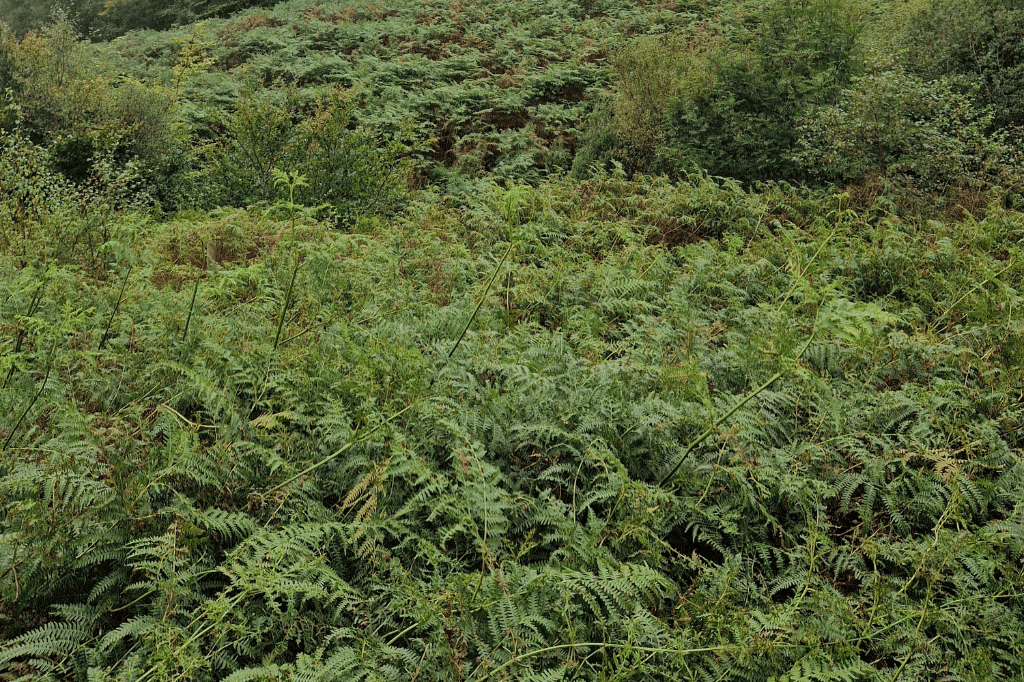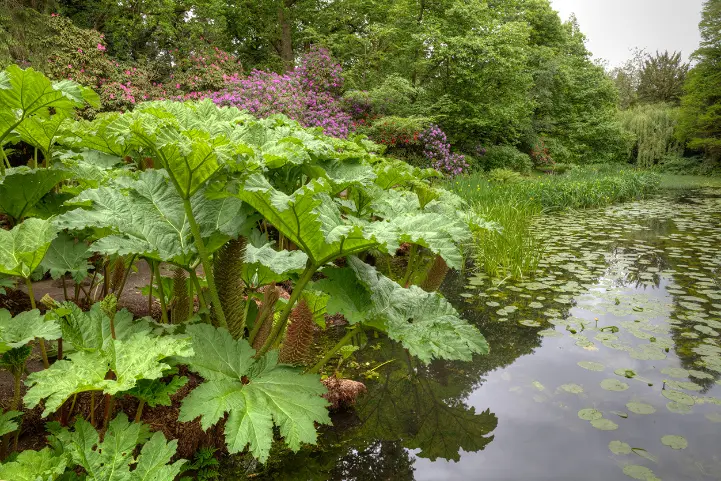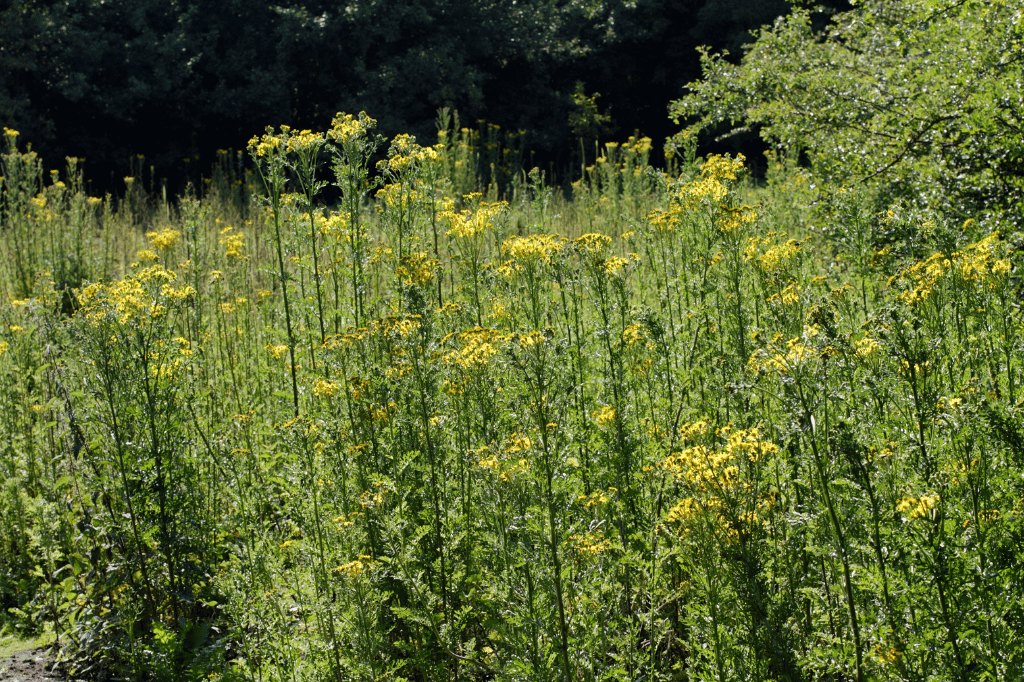
At Invasix Tree & Land Control, we specialise in professional invasive species control across Argyll and the West of Scotland. From targeted herbicide application where appropriate to mechanical methods such as cutting, digging, and root removal, we provide safe, effective treatments tailored to each site and species.
Bracken is a highly aggressive fern that spreads quickly through underground rhizomes, allowing it to take over vast areas of land in a short period of time. Once established, it forms dense carpets that block light from reaching other plants, leading to a dramatic loss of biodiversity.
Originally planted as an ornamental shrub, Rhododendron ponticum has become one of the UK’s most damaging invasive plants. Its thick, evergreen canopy blocks out sunlight, smothering native wildflowers, ferns, and young trees.
Japanese Knotweed is one of the most notorious invasive plants in the UK due to its destructive growth and resilience. Its powerful root system (rhizomes) can extend several metres underground and push through tarmac, concrete, and even building foundations, causing significant structural damage.
With its tall stems and bright pink flowers, Himalayan Balsam may look attractive, but it poses serious problems for land and waterways. It grows quickly in dense stands, especially along rivers, ditches, and wetlands, where it outcompetes native plants and alters natural habitats.
Giant Hogweed is a striking but extremely dangerous invasive plant. Growing up to five metres tall with umbrella-like flower heads, it spreads rapidly in open spaces, particularly along riverbanks and waste ground.
Known as “giant rhubarb,” Gunnera manicata is a dramatic plant with huge leaves that can span over two metres. While it may seem impressive in gardens, when it escapes into the wild it becomes a serious invasive species.
Ragwort is a familiar yellow-flowered weed found in fields, verges, and pastures across the UK. While it may seem harmless, it contains toxic alkaloids that are highly poisonous to livestock, particularly horses and cattle.
Bracken is a highly aggressive fern that spreads quickly through underground rhizomes, allowing it to take over vast areas of land in a short period of time. Once established, it forms dense carpets that block light from reaching other plants, leading to a dramatic loss of biodiversity.
For farmers and landowners, bracken infestations reduce the value of grazing land and create habitats for pests such as ticks, which can spread diseases to livestock, pets, and even people. Left unmanaged, bracken is extremely difficult to control and will steadily increase in coverage year after year.
Professional treatment prevents this spread, restores land usability, and protects the health of both animals and people.


Originally planted as an ornamental shrub, Rhododendron ponticum has become one of the UK’s most damaging invasive plants. Its thick, evergreen canopy blocks out sunlight, smothering native wildflowers, ferns, and young trees.
Over time, it can create near-lifeless monocultures where very little else can grow. To make matters worse, Rhododendron is a known host for Phytophthora ramorum, a deadly plant disease capable of infecting larch, oak, and other tree species.
Once Rhododendron takes hold, it spreads rapidly and is extremely hard to eradicate without specialist intervention. Controlling it not only protects native woodlands but also reduces the risk of disease spread and helps restore healthy, biodiverse habitats.
Japanese Knotweed is one of the most notorious invasive plants in the UK due to its destructive growth and resilience.
Its powerful root system (rhizomes) can extend several metres underground and push through tarmac, concrete, and even building foundations, causing significant structural damage. This makes it a major concern for homeowners, developers, and mortgage lenders, as properties affected by Knotweed can lose considerable value.
Once established, it grows rapidly and spreads aggressively, with small fragments of root or stem able to regenerate into new plants. Leaving it untreated only increases long-term costs. Professional treatment is essential to bring infestations under control, protect property investments, and ensure land can be safely developed or sold.


With its tall stems and bright pink flowers, Himalayan Balsam may look attractive, but it poses serious problems for land and waterways.
It grows quickly in dense stands, especially along rivers, ditches, and wetlands, where it outcompetes native plants and alters natural habitats. Its explosive seed pods can fire seeds several metres, spreading infestations downstream and into new areas with ease.
The real damage occurs in winter, when the plant dies back completely, leaving bare and unstable soil exposed to erosion and flooding. Effective control not only prevents further spread but also protects riverbanks, improves biodiversity, and reduces costly damage to land and infrastructure caused by erosion.
Giant Hogweed is a striking but extremely dangerous invasive plant. Growing up to five metres tall with umbrella-like flower heads, it spreads rapidly in open spaces, particularly along riverbanks and waste ground.
Its sap contains toxic chemicals (furanocoumarins) that cause severe blistering and burns when it contacts skin and is exposed to sunlight – injuries that can leave permanent scarring and long-term sensitivity.
For this reason, it is a serious hazard to the public, pets, and landowners, and must be handled with extreme care. In addition to its health risks, it displaces native species and destabilises riverbanks, worsening erosion problems. Immediate, professional control is vital to ensure safety and prevent this plant from spreading further.


Known as “giant rhubarb,” Gunnera manicata is a dramatic plant with huge leaves that can span over two metres.
While it may seem impressive in gardens, when it escapes into the wild it becomes a serious invasive species. In damp or riverside environments, it spreads to form large, dense colonies that overshadow and smother native plants. This can lead to significant loss of biodiversity and alter the natural balance of sensitive habitats such as wetlands and streambanks. Once established, Gunnera is very difficult to eradicate due to its massive root system and prolific seed production.
Professional treatment ensures infestations are tackled safely and effectively, restoring landscapes and protecting local ecosystems from being overwhelmed.
Ragwort is a familiar yellow-flowered weed found in fields, verges, and pastures across the UK. While it may seem harmless, it contains toxic alkaloids that are highly poisonous to livestock, particularly horses and cattle.
The danger is that Ragwort remains toxic even when dried in hay or silage, meaning accidental ingestion is a constant risk. In addition to the severe threat it poses to animal welfare, Ragwort spreads rapidly by wind-borne seeds, quickly colonising fields and reducing the quality and usability of pastureland.
Effective management is essential to protect grazing animals, maintain farmland productivity, and comply with legal responsibilities around controlling this harmful weed.

Different invasive species require different approaches. We tailor our methods to suit both the plant and the site.
Remove dense growth, prevent spread, followed by stump treatment.
Stops regrowth from roots after cutting.
Direct herbicide injection for tough species like Japanese Knotweed & Giant Hogweed.
Effective for widespread infestations.
Best for smaller sites or sensitive environments.
Combines techniques over seasons for long-term eradication.
Whether you need invasive species treatment, tree felling, or scrub clearance, we’re here to help. Contact us today for a free consultation.